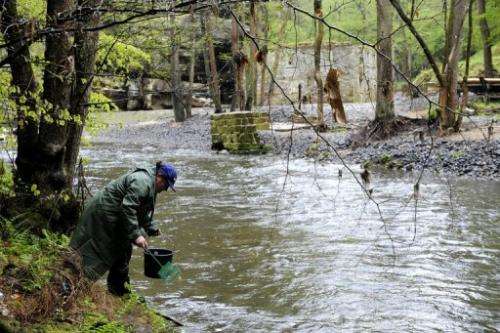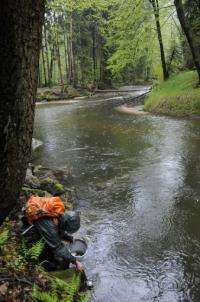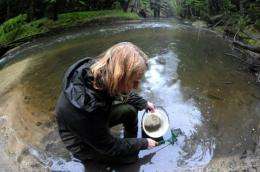Salmon swim again in Czech Elbe river

Salmon are flashing silver again in the Elbe river and its many tributaries in the Czech Republic as the waterway slowly bounces back from four decades of communist-era pollution.
"The salmon symbolises the remarkable efforts that are needed today to put right the sins committed by our predecessors," says Tomas Salov, a wildlife manager at the "Czech Switzerland" national park.
"Today, this fish is the flagship of our reintroduction programmes," Salov told AFP in the village of Jetrichovice, tucked away in the mountains of the northern Czech Republic.
Salmon is considered a "bio-indicator" whose presence in the river suggests improved water purity.
Once abundant in the Elbe, the fish vanished from the picturesque waterway after World War II as communist-era heavy industry dumped tonnes of toxic waste into it between 1948-1989, making it a stinking sewer in some areas.
Salmon were last recorded in the Czech part of the 1,165-kilometre (724-mile)-long Elbe river in 1954.
Locals from the cosy summer resort of Hrensko near the German border recall that during communism the once crystal-clear Kamenice river, a narrow tributary of the Elbe, changed colours depending on the colour of paper produced in a factory in Ceska Kamenice, a town about 20 kilometres (12.4 miles) up-stream.

"Today we can say that the quality of water here is good," says Pavel Benda, head of the national park, which covers an area of 79 square kilometres (30.5 square miles). It was established in 2000 as the youngest of the country's four national parks.
"The Kamenice was polluted by local industrial production which is no longer active. Larger towns have also received subsidies to build water treatment plants" since the demise of communism, he added.
With its sandstone rock, lush forests and picturesque rivers and brooks, the national park bordered on one side by the Elbe is a strategic spot for the reintroduction of salmon to Czech waters, Benda said.
Fish steps allowing the salmon to migrate up-river across dams were also part of the conservation programme kicked-off in 1998.
By 2006, a fisherman caught a huge salmon that measured 1.04 metres (1.13 yards) in Hrensko, but after photographing the impressive catch, he released the strictly protected fish back into the wild, in line with regulations.
According to Tomas Kava from the Czech Fishing Union, two to 10 adult salmon have been observed annually in the Czech part of the Elbe since then. Neighbouring Germany started a similar salmon repopulation project in 2002.
"The programme is aimed at stabilising the salmon population in the Czech Republic and at reintroducing the fish to rivers after almost 50 years of absence caused by human activity," says Kava.

Each May, dozens of enthusiasts carefully release salmon fry into the tiny Czech tributaries of the Elbe, a major European river.
"Over the years, we have released 100,000-200,000 fish fry annually," says Kava, who marvels at the epic journey salmon make during their lifetime.
After two or three years, they swim down the Elbe to the North Sea and the Atlantic Ocean, and then after several years in the open sea, those that survive return to the Elbe's sweet waters to spawn.
"Their sense of direction is unique. There are a myriad of methods they use in the sea and in rivers -- among others, salmon find their way using the earth's magnetic field and the sea's currents but also the position of stars," Kava said.
(c) 2011 AFP














